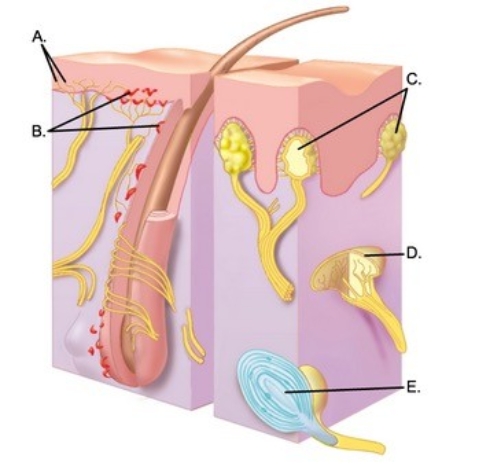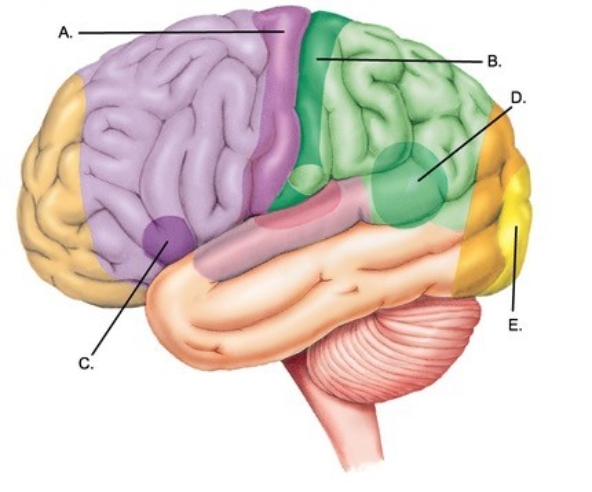A) referred pain
B) central sensitization
C) peripheral sensitization
D) cumulative sensitization
E) phantom pain
G) All of the above
Correct Answer

verified
Correct Answer
verified
Multiple Choice
Match the sensation with the appropriate receptor type. -Pacinian corpuscles
A) Mechanoreceptors
B) Thermoreceptors
C) Nociceptors
D) Chemoreceptors
E) Photoreceptors
G) D) and E)
Correct Answer

verified
Correct Answer
verified
Multiple Choice
Which tracts represent direct motor pathways? (Check all that apply.)
A) Corticobulbar
B) Corticospinal
C) Reticulospinal
D) Rubrospinal
E) Tectospinal
G) A) and B)
Correct Answer

verified
Correct Answer
verified
Short Answer
 -What is the function of the sensory receptor of the skin labeled "A"?
A) Detects deep pressure, vibration, and proprioception
B) Responds to painful stimuli and temperature
C) Responds to light touch and superficial pressure
D) Detects touch, involved in 2-point discrimination
E) Detects continuous touch or pressure
-What is the function of the sensory receptor of the skin labeled "A"?
A) Detects deep pressure, vibration, and proprioception
B) Responds to painful stimuli and temperature
C) Responds to light touch and superficial pressure
D) Detects touch, involved in 2-point discrimination
E) Detects continuous touch or pressure
Correct Answer

verified
Correct Answer
verified
Short Answer
 -Label area "E" on the cerebral cortex.
A) Visual cortex
B) Primary motor cortex
C) Primary somatosensory cortex
D) Motor speech area (Broca'sarea)
E) Sensory speech area (Wernicke area)
-Label area "E" on the cerebral cortex.
A) Visual cortex
B) Primary motor cortex
C) Primary somatosensory cortex
D) Motor speech area (Broca'sarea)
E) Sensory speech area (Wernicke area)
Correct Answer

verified
Correct Answer
verified
Multiple Choice
The brainstem
A) includes nuclei of cranial nerves II - XII.
B) contains centers for several vital reflexes like heart rate and blood pressure.
C) contains the reticular formation.
D) contains nuclei for vomiting and sneezing reflexes.
E) All of the choices are correct.
G) None of the above
Correct Answer

verified
Correct Answer
verified
Short Answer
 -Label area "D" on the cerebral cortex.
A) Visual cortex
B) Primary motor cortex
C) Primary somatosensory cortex
D) Motor speech area (Broca area)
E) Sensory speech area (Wernicke area)
-Label area "D" on the cerebral cortex.
A) Visual cortex
B) Primary motor cortex
C) Primary somatosensory cortex
D) Motor speech area (Broca area)
E) Sensory speech area (Wernicke area)
Correct Answer

verified
Correct Answer
verified
Multiple Choice
When people smoke cigarettes, they damage some of their taste buds. Which type of sense has been damaged by the smoking?
A) Special
B) Somatic
C) Visceral
D) Autonomic
E) Nonspecialized
G) C) and E)
Correct Answer

verified
Correct Answer
verified
Multiple Choice
In an ascending pathway, axons of the secondary neuron travel from the
A) receptor to the spinal cord.
B) receptor to the brain.
C) spinal cord through the brainstem to the thalamus.
D) thalamus to the cerebral cortex.
E) spinal cord to cerebellum.
G) A) and D)
Correct Answer

verified
Correct Answer
verified
Multiple Choice
Alan has experienced several stokes over the past few months. He is unable to move his right arm and leg. In addition, he is having difficulty speaking. Which of the following areas is most likely affected?
A) Left frontal lobe of the cerebrum
B) Right frontal lobe of the cerebrum
C) Left parietal lobe of the cerebrum
D) Right parietal lobe of the cerebrum
F) All of the above
Correct Answer

verified
Correct Answer
verified
Multiple Choice
Which of the following receptor type is mismatched with its sensation?
A) Merkel disks - light touch
B) Pacinian corpuscles - vibration
C) Meissner corpuscles - two-point discrimination
D) Ruffini end organs - temperature
E) Hair follicle receptors - slight bending of the hair
G) A) and C)
Correct Answer

verified
Correct Answer
verified
Multiple Choice
Lack of a gag reflex would indicate dysfunction of the ________ nerve.
A) glossopharyngeal
B) trochlear
C) trigeminal
D) accessory
F) None of the above
Correct Answer

verified
Correct Answer
verified
Multiple Choice
When a person is exposed to temperature extremes, why is it difficult to distinguish hot from cold objects?
A) Temperature perception requires more than one type of receptor.
B) Temperatures above 37 degrees centigrade actually stimulate the cold receptors.
C) At extremes, pain receptors are stimulated by both very hot and very cold objects.
D) Most temperature receptors cannot differentiate hot from cold.
E) Pain receptors are inhibited by both very hot and very cold objects.
G) None of the above
Correct Answer

verified
Correct Answer
verified
Multiple Choice
Superficial pain is highly localized, but visceral pain is diffuse because
A) the viscera has fewer pain receptors.
B) the skin has more sensitive pain receptors.
C) the viscera has fewer mechanoreceptors which give location information.
D) visceral pain has less emotional involvement.
F) A) and B)
Correct Answer

verified
Correct Answer
verified
Multiple Choice
Which of these activities is associated with the right cerebral hemisphere in most people?
A) Adding numbers
B) Reciting the Gettysburg address
C) Painting a watercolor landscape
D) Using a calculator
E) Making a household budget
G) C) and D)
Correct Answer

verified
Correct Answer
verified
True/False
Visceroreceptors are receptors associated with joints, tendons, and other connective tissue.
B) False
Correct Answer

verified
Correct Answer
verified
Multiple Choice
Which of the following pairs is mismatched?
A) Left cerebral hemisphere - analytical hemisphere
B) Left cerebral hemisphere - speech area for most of the population
C) Right cerebral hemisphere - recognition of faces
D) Left cerebral hemisphere - spatial perception
E) Left cerebral hemisphere - mathematics
G) C) and D)
Correct Answer

verified
Correct Answer
verified
Multiple Choice
Which of the cortical areas listed below is most likely to be stimulated first when repeating a word you just heard spoken?
A) Auditory association area
B) Broca area
C) Primary motor area
D) Primary auditory cortex
E) Wernicke area
G) A) and D)
Correct Answer

verified
Correct Answer
verified
Multiple Choice
Various areas of the cortex form functional pathways to conduct action potentials necessary to perform specific functions. Arrange the areas below in proper sequence to accomplish reading a poem aloud. (1) Visual association area (2) Premotor area (3) Broca area (4) Primary motor area (5) Wernicke area (6) Visual cortex
A) 1, 6, 5, 3, 4, 2
B) 6, 1, 5, 3, 2, 4
C) 6, 1, 3, 5, 4, 2
D) 1, 2, 4, 5, 6, 3
E) 5, 4, 3, 6, 1, 2
G) A) and D)
Correct Answer

verified
Correct Answer
verified
Multiple Choice
Specialized muscle fibers associated with detection of muscle length are ________.
A) muscle spindles
B) Pacinian corpuscles
C) Ruffini end organs
D) Golgi tendon organs
E) Merkel disks
G) A) and B)
Correct Answer

verified
Correct Answer
verified
Showing 61 - 80 of 149
Related Exams